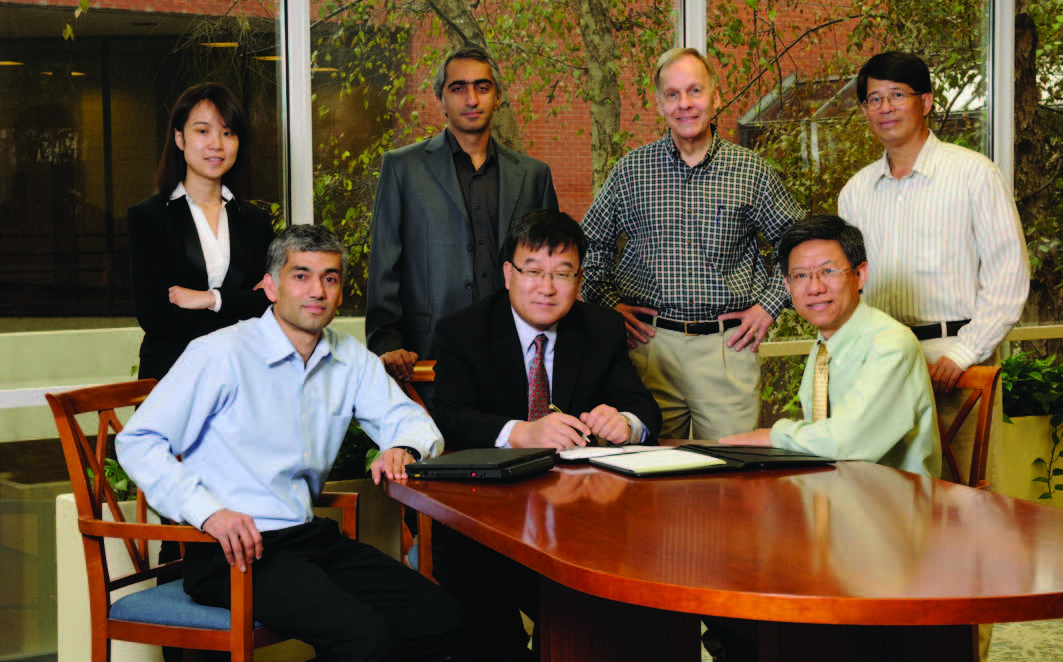In Nagi Gebraeel’s lab, success is measured by the ability to anticipate failure.
Gebraeel, the Chandler Family Associate Professor in ISyE, and his Ph.D. students use sensor data from a turbojet simulation to document the various scenarios that predict engine malfunction or failure. Their work will help extend engine life through improved condition-based maintenance scheduling and may also be a source for future design enhancements.
Nowadays, virtually every industrial or engineering system new or in design is embedded with dedicated microelectromechanical devices. These high-speed, highly sensitive sensors capture and transmit data in real time about dozens, sometimes hundreds, of key measures— everything from chemical interactions and energy consumption to product quality and output volume. This information helps engineers fine-tune systems so as to improve efficiency and reliability, and reduce costs.
Sorting, processing and analyzing the enormous amount of sensor output into useful, actionable data requires engineers with a high degree of expertise in a number of areas. Recognizing the growing need for these specialists, ISyE introduced a Ph.D. specialization in system informatics and control (SIAC) in 2008.
The newest of ISyE’s Ph.D. specializations, SIAC develops research and education programs that provide a scientific base for the design, analysis and control of complex manufacturing and service systems in data-rich environments, according to Jan Shi, the Carolyn J. Stewart Chair and professor in ISyE.
“The conventional methods for system modeling and analysis are either physical-driven or data-driven. However, each method has its own limitations for a complex system,” said Shi, who heads the SIAC program. “ The SIAC group emphasizes data fusion through developing engineering-driven statistical methods for system modeling and analysis, which leads to much better performance of system monitoring, diagnosis, and control.”
Gebraeel’s failure-prediction project relies on a jet-engine simulator — a physical engine would be too expensive — with 21 sensors streaming data 24/7.
“It’s a big challenge just handling that amount of data,” he said. “We first had to develop a selection algorithm to determine which of the 21 sensors were the most informative. Not all the information you get from all 21 sensors is necessary. Bad information contaminates good information, so you want to exclude data that causes inaccuracies in the prediction.”
Next, the data is fused through a sophisticated algorithm called multivariate functional principle component analysis or MFPCA. This is a data reduction process — what
Gebraeel calls “dimensionality reduction of the information” — that does not sacrifice the information content.
The final step is to study and model the fused data such that the remaining lifetime of key engine components that are functioning in the field can be predicted accurately and in real-time.
Another applied research project, conducted by Shi and his graduate students, concerned a traditional industry: steel. This work, funded by the Department of Energy and conducted in partnership with OG Technologies of Ann Arbor, Mich., involved the use of in-line sensing devices at a U.S.-based steel mill.
“We analyzed real-time data from the production line and developed algorithms for the on-line measurement of quality in the product, which is very, very hot — a thousand degrees or more,” Shi explained. “We also provided suggestions about how to improve production efficiency.”
The project substantially reduced the number of defects, thereby lowering energy consumption and environmental costs due to less waste and less product re-work. The steel company client followed up by deploying the quality- control algorithm at its mills elsewhere in the U.S., plus Europe, Japan, and China.
In addition to its research component, the SIAC concentration includes six core courses and a minimum of three courses from related fields such as stochastics and simulation, statistics, and dynamics and control.
Kaibo Liu is a recent graduate of the SIAC Ph.D. specialization. In November 2013 he joined the faculty of the Industrial and Systems Engineering Department at the University of Wisconsin-Madison as an assistant professor. Liu first learned about the SIAC concentration as an undergraduate at the University of Hong Kong, from two of his professors who happened to be former students of Professor Shi’s.
“I was very interested in and good at applied statistics,” he said. “And as an engineering student, I also had a strong foundation in engineering fundamentals and in-depth domain knowledge. The SIAC program was a perfect match for me, as it requires developing quantitative models to integrate data extraction and engineering knowledge, and employs the models in the analysis and control of complex manufacturing and service systems.”
Liu credits the SIAC program with imparting the research skills he needs in his new position. “This program taught me how to develop novel research ideas, formulate and solve interesting problems, and write-up the results for journals and research papers.”
Another SIAC alumnus is Ran Jin, who was particularly impressed by the SIAC faculty. “I think the SIAC group has the best scholars in this field,” said Jin, an assistant professor of industrial and systems engineering at Virginia Tech. “Although they have very different backgrounds and skills, their areas of expertise are complementary, which makes the courses and research strong.”
Written by: Gary Goettling
This article first appeared in the Fall 2013 ISyE Alumni Magazine.
